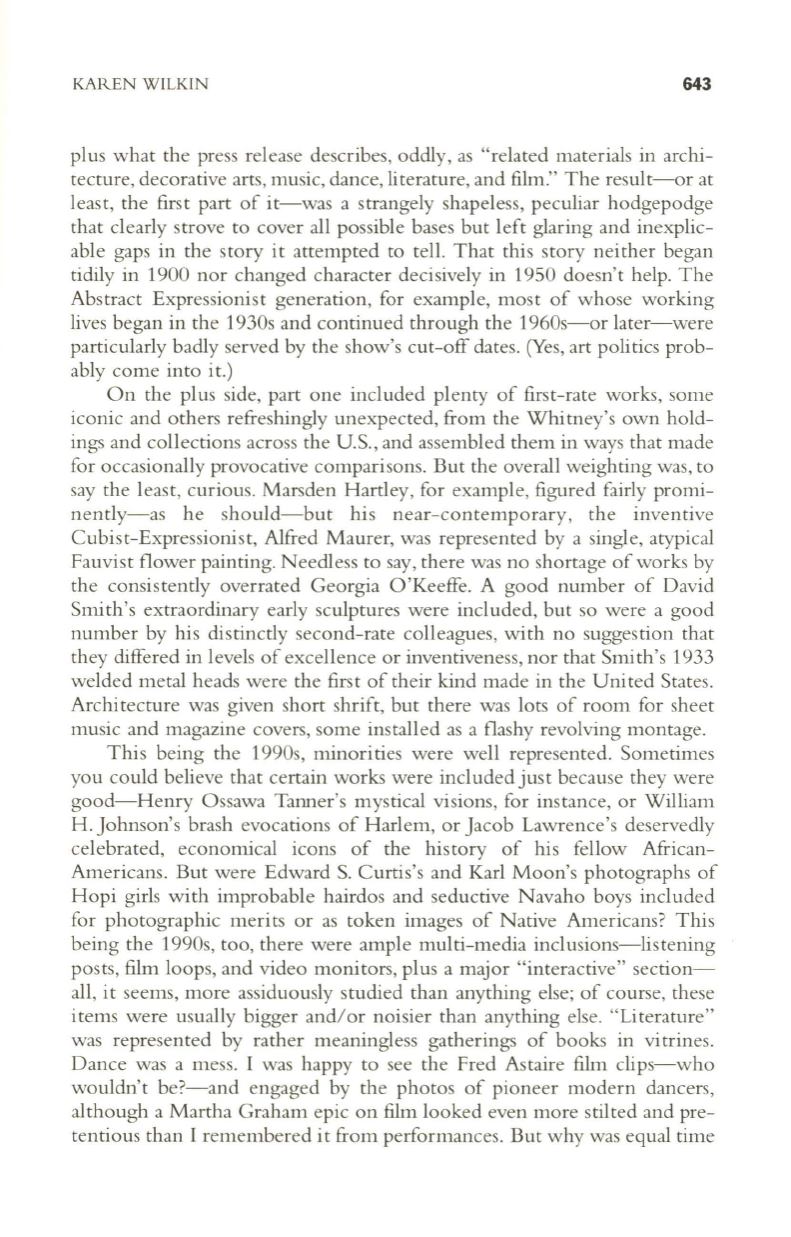
KAREN WILKIN
643
pi us what the press release describes, oddly, as "related materials in archi–
tecture, decorative arts, music, dance, literature, and film." The result-or at
least, the first part of it-was a strangely shapeless, peculiar hodgepodge
that clearly strove to cover all possible bases but left glaring and inexplic–
able gaps in the story it attempted to tell. That this story neither began
tidily in 1900 nor changed character decisively in 1950 doesn't help. The
Abstract Expressionist generation, for example, most of whose working
lives began in the 1930s and continued through the 1960s-or later-were
particularly badly served by the show's cut-off dates. (Yes, art poli tics prob–
ably come into it.)
On the plus side, part one included plenty of first-rate works, some
iconic and others refreshingly unexpected, from the Whitney's own hold–
ings and collections across the U.S., and assembled them in ways that made
for occasionally provocative comparisons. But the overall weighting was, to
say the least, curious. Marsden Hartley, for example, figured fairly promi–
nently-as he should-but his near-contemporary, the inventive
Cubist-Expressionist, Alfred Maurer, was represented by a single, atypical
Fauvist flower painting. Needless to say, there was no shortage of works by
the consistently overrated Georgia O'Keeffe. A good number of David
Smith's extraordinary early sculptures were included, but so were a good
number by his distinctly second-rate colleagues, with no suggestion that
they differed in levels of excellence or inventiveness, nor that Smi th's 1933
welded metal heads were the first of their kind made in the United States.
Architecture was given short shrift, but there was lots of room for sheet
music and magazine covers, some installed as a flashy revolving montage.
This being the 1990s, minorities were well represented. Sometimes
you could believe that certain works were included just because they were
good-Henry Ossawa Tanner's mystical visions, for instance, or William
H. Johnson's brash evocations of Harlem, or Jacob Lawrence's deservedly
celebrated, economical icons of the history of his fellow African–
Americans. But were Edward S. Curtis's and Karl Moon's photographs of
Hopi girls with improbable hairdos and seductive Navaho boys included
for photographic merits or as token images of Native Americans? This
being the 1990s, too, there were ample multi-media inclusions-listening
posts, film loops, and video monitors, plus a major "interactive" section–
all, it seems, more assiduously studied than anything else; of course, these
items were usually bigger and/or noisier than anything else. "Literature"
was represented by rather meaningless gatherings of books in vi trines.
Dance was a mess. I was happy to see the Fred Astaire film clips-who
wouldn't be?-and engaged by the photos of pioneer modern dancers,
although a Martha Graham epic on film looked even more stilted and pre–
tentious than I remembered it from performances. But why was equal time


